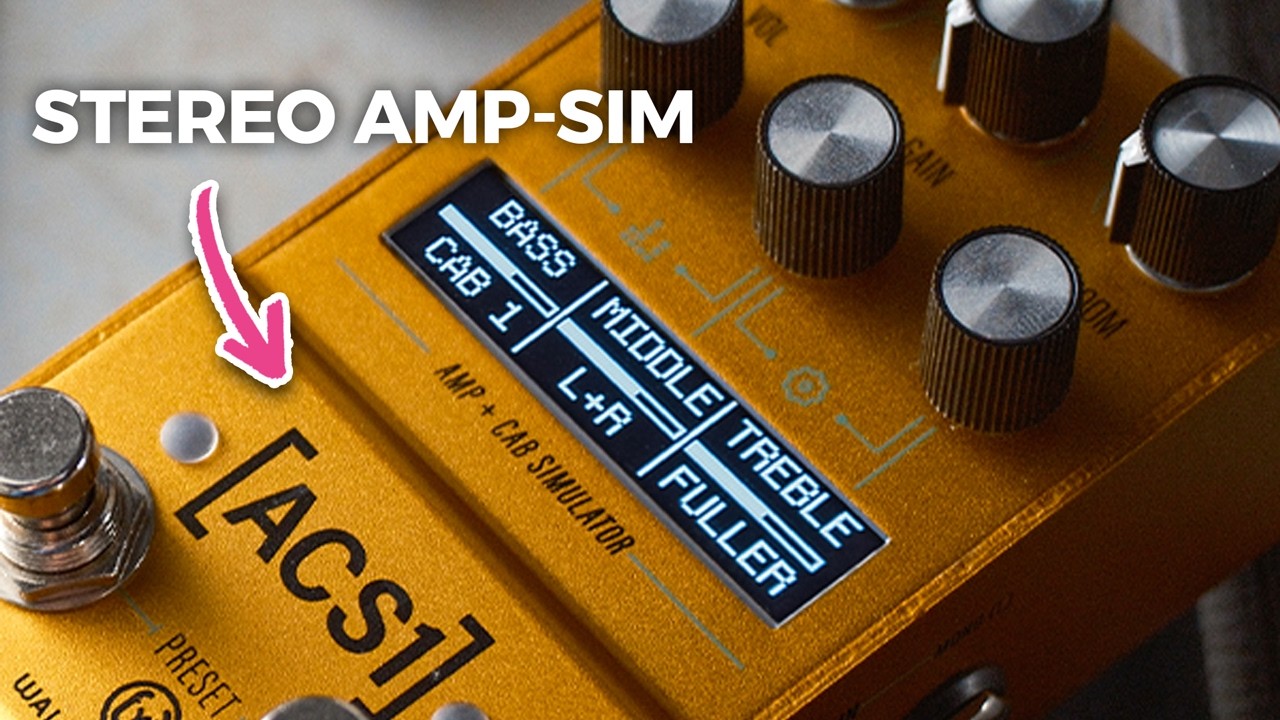
Walrus Audio ACS1 MKII // Real Amp Feel. Modern Freedom.
Share

If you’re on the hunt for a compact, high-quality amp sim that delivers authentic amp dynamics without the bulk, the Walrus Audio ACS1 MKII might just be the answer. In this detailed review and hands-on exploration, we dive into what makes this pedal a standout in the world of amp modeling, blending simplicity with powerful tone options and practical functionality.

Introduction to the Walrus Audio ACS1 MKII
As a musician and gear enthusiast, I’ve had my fair share of amp modelers and pedals. From Fractal to HeadRush and NeuroDSP, I’ve explored many solutions for capturing great tone in a flexible, portable format. Yet, there’s always been something special about hands-on gear that lets you tweak your sound intuitively without diving into complex menus or touchscreen interfaces. The Walrus Audio ACS1 MKII embodies this philosophy perfectly.
The ACS1 MKII is a full stereo amp experience in a box, designed to give you a real amp feel with modern freedom. It’s not just a cab sim; it’s an all-in-one solution that offers a wide range of amp models, hands-on controls, and a compact footprint that’s easy to integrate into any rig or practice setup.
Why the ACS1 MKII Stands Out
Having tried the original ACS1 last year, I was impressed by its sound but felt it could improve in certain areas, especially with dirtier tones and user options. The MKII version addresses many of these concerns and elevates the pedal to a new level.

The Addition of a Screen
One of the most significant upgrades in the MKII is the addition of a screen. While the original model required you to rely heavily on your ears and manual adjustments, the screen now lets you visually reference your settings. This is a huge convenience for dialing in your tone quickly and coming back to the exact spot later.
Despite the screen, the pedal retains the intuitive, hands-on feel, so you don’t lose that essential ear training element. You get the best of both worlds: precision and convenience.
Expanded High Gain Options
High gain tones are crucial for many players, and the original ACS1 left me leaning toward the Strymon Iridium for its killer Marshall amp sim. The MKII has closed that gap by adding several new high gain amp models, including:
- 5150
- Orange
- Mesa Boogie
These additions complement the existing London, Dartford, and Bluesbreaker models, giving you a comprehensive palette of tones without feeling overwhelming or excessive.
The high gain tones themselves have been refined to sound less crackly or “papery” at the top end, delivering a smoother and more realistic distortion that holds up well at higher gain settings.
Simplicity Meets Practicality
One of my core values when it comes to gear is practicality. I appreciate equipment that helps me get the sound I want quickly and intuitively without fussing over complicated setups. The ACS1 MKII fits this bill perfectly.
Think of it as a regular amp with just a few more options — it’s grab-and-go simplicity. You can move from clean to dirty tones by tweaking just a few knobs, making it ideal for both practice and performance.
All the sounds you hear in my demos are 100% stock, with no added reverb, delay, or other effects in post-production. This raw tone is a testament to the quality of the pedal’s modeling and internal settings.
Stereo Capability in a Compact Package
The pedal’s stereo output is another underrated feature. Stereo rigs and recording setups benefit tremendously from this, as you can run dual rigs or create wide, immersive sounds without needing bulky equipment. The fact that this stereo capability comes in such a small footprint is impressive and extremely useful for both live and studio applications.
Advanced Features and Preset Management
Despite its simplicity, the ACS1 MKII packs plenty of advanced features for those who want them. It supports 128 presets via MIDI, allowing extensive customization and storage for different tones and setups.
Onboard, you can save three presets accessible with double-tap footswitch presses, making it easy to switch between tones on the fly. The footswitches themselves have push-pull functionality, letting you adjust parameters like volume, gain, and room reverb quickly.

The amp settings are split between the top and bottom rows of knobs, with additional functionality accessible by pushing the knobs in. This design keeps the control layout clean while offering flexibility for dialing in your perfect sound.
Integration with IRs and External Gear
The ACS1 MKII includes York Audio impulse responses (IRs) and David Hlops IRs, both of which I’m a huge fan of. These IRs contribute to the realistic cabinet simulations and overall tone quality, enhancing the pedal’s versatility.
For recording purposes, this pedal is a fantastic raw tone source. Instead of relying on built-in delays or reverbs, you can add these effects later in your DAW, providing maximum control over your final sound. Its straightforward signal chain also makes reamping easier, allowing you to record a clean signal and process it through the pedal afterward.
Who Is the Walrus Audio ACS1 MKII For?
This pedal is incredibly versatile and can serve a wide range of guitarists, but here are some of the primary use cases I see:
1. Players Seeking Great Tone with Simplicity
If you want excellent amp tones without the hassle of complicated interfaces or heavy equipment, this pedal is perfect. Plug it in, and you have all the essential amp voices you need, from classic Fender cleans and AC30 tones to high gain 5150 and Mesa Boogie sounds.
It even includes a headphone jack, making it a portable practice machine that you can take anywhere, especially if paired with a portable power supply.
2. Central Hub for Pedalboards
If you run a traditional pedalboard and want a compact amp sim that can serve as your tone foundation, the ACS1 MKII fits seamlessly into your rig. It’s mini MIDI capable, so you can integrate it with your existing controllers and easily manage presets.
3. Recording and Reamping
For home studio users, this pedal offers a solid, high-quality raw tone that can be recorded directly. Its clean signal path and realistic amp models make it a great starting point before adding effects or additional processing in your DAW.
4. Those New to Modeling
If you’re just stepping into the world of amp modeling and want something that feels familiar and intuitive, this pedal is a fantastic entry point. It’s easier to adjust than some touchscreen-based modelers and offers enough tonal variety to cover most styles.
How It Compares to Other Modelers
Compared to other popular modelers like the Strymon Iridium or the Line 6 Tone X, the ACS1 MKII stands out for its hands-on control and tonal flexibility. While the Tone X offers many features and incredible sounds, I personally found the ACS1 MKII easier to tweak and more satisfying for gain structure adjustments.
The added screen and new amp models make it competitive with—and in some ways superior to—other pedals in this category, especially for players who want that “real amp feel” in a portable format.
Final Thoughts
The Walrus Audio ACS1 MKII is a knockout winner in the amp sim pedal market. It balances modern technology with a hands-on, practical design philosophy that makes it accessible and fun to use.
Whether you’re looking for a simple practice tool, a central hub for your pedalboard, or a recording solution with authentic amp tones, this pedal delivers. Its stereo output, expanded amp options, and intuitive controls set it apart from many competitors.
In short, if you want a pedal that gives you real amp dynamics in a compact, portable package with modern freedom and flexibility, the ACS1 MKII is a fantastic choice. I’m so impressed that I’m planning to add one to my own setup for instant access to great tones and plug-and-play convenience.

Where to Get the ACS1 MKII
If you’re interested in picking up the Walrus Audio ACS1 MKII, you can find it through various retailers, including Zzounds. Supporting the channel through these links helps keep reviews like this coming.
Gear Used in This Review
- Walrus Audio ACS1 MKII Amp Sim Pedal
- PRS Special Semi Hollow Guitar
- PRS S2 Custom 24 Guitar
For those who want to dive deeper into the world of amp modeling or explore more gear reviews, feel free to leave a comment with your requests. I’m always eager to check out new tools and share my honest thoughts.
Thanks for reading, and here’s to great tone and effortless playing!
